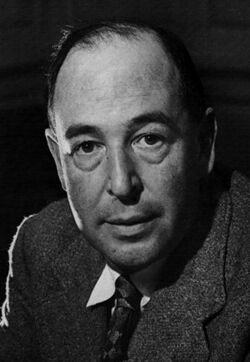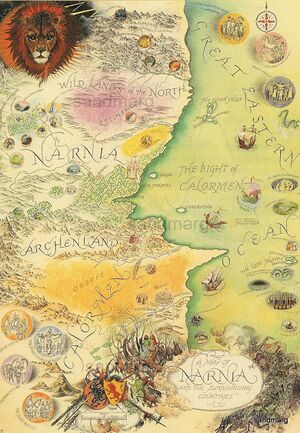C. S. Lewis

Clive Staples Lewis (better known as "C. S.", "Jack" to his friends), not to be confused with C.S. Goto (how dare you confuse the two), nor with Lewis Carroll, was J. R. R. Tolkien's good friend and another influential early modern fantasy writer. He was also an essayist and a theologian, one of the best of the last century, writing on subjects such as the relationship between science and religion in the modern age, the nature of the afterlife, and how the existence of aliens doesn't have to clash with Christianity.
Lewis was very good at reasoning and explaining his philosophy. Many of his more devoted fans would argue that reading his work is like reading the Necronomicon, except it increases your sanity. /tg/, at least, is more divided over his world-building... which we'll get to.
Trivia: His death didn't get much attention in the news because it largely overshadowed by media coverage of JFK's assassination, which happened the same day.
His Fictional Works
- The Space Trilogy
- Out of the Silent Planet (1938)
- Perelandra (1972) (C.S Lewis' favorite book by his own admission)
- That Hideous Strength (1974) (AKA That Hideous Book, according to JRR Tolkien).
- The Chronicles of Narnia (1950-1956)
- The Lion, the Witch and the Wardrobe
- The Horse and His Boy
- Prince Caspian
- The Voyage of the Dawn Treader
- The Silver Chair
- The Magician's Nephew (the prequel to all this; although its events take place before, as a story it assumes you care about Narnia's creation-myth. so, don't read this before TLTW&TW)
- The Last Battle
- The Screwtape Letters (His most difficult book to write, according to him)
- The Pilgrim's Regress
- The Great Divorce
- Till We Have Faces
Why He Was Influential
With the Narnia series, C. S. Lewis brought to the table the "everything in mythology but the kitchen sink" approach to fantasy writing. Norse Mythology, Greco-Roman Mythology, Judeo-Christian Theology, even modern folklore like Santa Claus got worked in. It's to his everlasting credit that he threw all these things into a blender and came up with something really awesome (even Santa Claus). Basically, if Tolkien gave modern fantasy RPGs Halflings, Orcs and Dark Lords, Lewis gave it Centaurs, Minotaurs (and potentially non-evil ones at that), Merfolk, and talking animals. Narnia also included one of the earliest and most logically consistent examples of the "secret magical world parallel to our own" trope. And it is also an early form of the Isekai genre.
On His Writing

When compared to his friend J.R.R. Tolkien, Lewis was more of a philosopher and theologian than a world-builder. While Tolkien had beliefs and viewpoints which manifested in his writings, they usually came up as background details and a component of greater world building. Lewis, in contrast, wrote his works with the primary intent of arguing a point or presenting an idea rather than creating a fantasy world. This isn't to say that Lewis' writings have poor world-building, it just wasn't as much of a priority for him as having a clear and consistent theme. Although his writings tend to be far more overt with their religious message, it should be noted that they're not written in a judgemental fire-and-brimstone style, but more like a neutral-toned fable or philosophy lecture. The Narnia series might basically be about a fantasy land with lion Jesus and ice witch Satan, but it is generally more readable than The Lord of the Rings, as Lewis didn't feel the need to include songs on every other page, or detail the name and lineage of every single person who participated in each battle.
He is also known for The Space Trilogy, which is arguably the earliest example of the subgenre Christian science fiction (an obscure but existent subgenre almost unheard of in mainstream media unless they're adapting out the Christian aspects). The first book (Out of the Silent Planet) is about a man named Ransom being kidnapped and taken to a planet (called Malacandra by its inhabitants, the one we call Mars) where he meets aliens, the angel in charge of Mars under God and learns more about the way the universe works and the situation of Earth. The second book (Perelandra) is about Ransom being taken to the planet Perelandra - our Venus - to stop a demon from recreating The Fall of Man with Venus' equivalent of Adam and Eve. In the third book (That Hideous Strength) the main characters Ransom and Mark have to work together against a scientific institute which is actually a front for sinister supernatural forces (read: at first glance they seem like your typical dystopian organization bent on ruling humanity, until its revealed that they're being lead by a decapitated demonically-possessed head that plans to use the recently reawakened Merlin for his sorcerous powers. Shit gets weird, yo.). Tolkien did not care for it for being being full of strawman versions of people and ideas that Lewis did not like.
In the 1930s-40s, scientists had figured out that Mars was uninhabitable except by magic, but still didn't know anything about hellworld Venus under its clouds. You can pretend Perelandra is offset in time, when our Sun was cooler, as well as in space, if you like. Or just consider it all Magical Realism.
On topic of that: the Space Trilogy makes reference to what would have been the Time Travel trilogy by J.R.R. Tolkien, except we never got anything more than unfinished manuscripts. Basically it would have been Tolkien's way of tying in the history of the Lord of the Rings with the known history and medieval legends of today's world. The closest thing we get is The Silmarillion.
Also of note are Lewis' books about the afterlife, as they were unique... at the time. They also don't quite mesh with each other; but that's okay because Lewis himself was not proposing to any seminary that we accept them as orthodoxy. The Great Divorce, for one, proposes a Hell that is a confused mess of a city always being torn down and rebuilt by its own dissatisfied inhabitants. (Certain planes in Baator may owe something to this.) If someone figures out how to get out of Hell, he will look back upon it as Purgatory; but those still down there, in their despair, cannot conceive of a way out, so just see it as Hell. The argument here is that miserable people are in misery due to their own choices and mindset, but could get out if they just choose to. That is, by choosing Christ.
The Screwtape Letters, by contrast, imposes more order upon the infernal reaches. This book is structured as a series of letters written by a demon, Screwtape, to his nephew Wormwood, giving him advice on seducing people to the ways of sin and damnation using the man they're currently trying to tempt on as an example. Hell isn't depicted as a brutal prison as in Dante's Inferno, but more like a diabolical bureaucracy; where demons consume human souls as we would consume wine, and the more evil they are, the finer their vintage. Screwtape gives excellent advice on how to manipulate good intentions into bad deeds, and the book's unusual point of view lends itself to some creative ideas. In particular, the subplot where Wormwood and Screwtape subtly try to undermine the other by reporting them to Hell's Inquisition while maintaining correspondence is quite entertaining. Suffice to say, it's an excellent read for GMs wishing to run a particularly cunning or manipulative demon.
Legacy
C.S Lewis' works have found use in various fields, from the fantasy genre to works outside fiction such as Christian apologetics. The Chronicles of Narnia have seen numerous adaptations and served as inspiration for numerous other world fantasy stories.
His non-fictional works have also gained notoriety, such as his book "Mere Christianity" which explores Christian worldview from a philosophical perspective, but puts it in layman terms. Some of his arguments have been cited by theologians and Christian apologists of various stripes. One of these arguments, his description of a logical fallacy he called "Bulverism", is also widely cited with approval by many Atheists.
Some of his fictional works have even led to some "follow the leader" style copycats, such as a duology books by author Randy Alcorn intended as an "updated" version of The Screwtape Letters, these revolving around the not-Screwtape demon Foulgrin and his subordinate - instead of nephew - Squaltaint. Intended as a guide against modern evils, it is less sophisticated than Lewis' work and tarred undeserving or contentious targets with the same brush... like Dungeons & Dragons (Foulgrin claims Dungeons and Dragons is a gateway to practicing actual black magic).
On the flip side not everyone appreciates overt religious preaching. Phillip Pullmano wrote His Dark Materials as an atheist response to CS Lewis. Which ended up as anti-religious preaching.
See Also
- CS Lewis Doodle, a YouTube channel which animates several of his essays and written works.